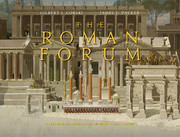Book contents
- Frontmatter
- Map
- Contents
- Preface
- Acknowledgments
- Part I. Architecture in the Roman Forum during the Empire: A Brief History
- Part II. The Monuments
- 3 The Temple of Antoninus and Faustina
- 4 The Temple of Caesar (Aedes divi Iuli)
- 5 The Basilica Æmilia
- 6 The Curia
- 7 The Arch of Septimius Severus
- 8 Minor Monuments
- 9 The Temple of Concord
- 10 The Temple of Vespasian
- 11 The Tabularium
- 12 The Portico of the Dei Consentes
- 13 The Temple of Saturn
- 14 The Basilica Julia
- 15 The Arch of Tiberius
- 16 The Schola Xanthi
- 17 The Diocletianic Honorary Columns
- 18 The Temple of Castor and Pollux
- 19 The Parthian Arch of Augustus (19 BCE)
- 20 The Temple of Vesta
- Part III. Conclusions
- Glossary
- Notes
- Bibliography
- Sources for Coin Images from the Internet and for Other Images
- Index
10 - The Temple of Vespasian
from Part II. - The Monuments
Published online by Cambridge University Press: 05 March 2015
- Frontmatter
- Map
- Contents
- Preface
- Acknowledgments
- Part I. Architecture in the Roman Forum during the Empire: A Brief History
- Part II. The Monuments
- 3 The Temple of Antoninus and Faustina
- 4 The Temple of Caesar (Aedes divi Iuli)
- 5 The Basilica Æmilia
- 6 The Curia
- 7 The Arch of Septimius Severus
- 8 Minor Monuments
- 9 The Temple of Concord
- 10 The Temple of Vespasian
- 11 The Tabularium
- 12 The Portico of the Dei Consentes
- 13 The Temple of Saturn
- 14 The Basilica Julia
- 15 The Arch of Tiberius
- 16 The Schola Xanthi
- 17 The Diocletianic Honorary Columns
- 18 The Temple of Castor and Pollux
- 19 The Parthian Arch of Augustus (19 BCE)
- 20 The Temple of Vesta
- Part III. Conclusions
- Glossary
- Notes
- Bibliography
- Sources for Coin Images from the Internet and for Other Images
- Index
Summary
Antiquity
When the emperor Vespasian died in 79 CE, his son, Titus, succeeded him. In the next year, the Senate canonized the deceased emperor, and shortly thereafter Titus began the temple for his father. After Titus’ premature death in 81, Domitian, his brother and successor, continued the project and finished it before 87. Despite its prominent location and rich decoration (Figs. 0.4, 1.3, 10.6–10; see pp. 192−195), during the reign of Domitian, only the poet Statius mentioned it briefly in a flowery composition that celebrates the emperor’s now long-lost equestrian statue in the Forum. Thereafter, we hear nothing of the temple until its restoration by Septimius Severus, an event commemorated by a grand dedication in gilt bronze letters on the front of the entablature (infra, pp. 192−193). References to the temple in late antiquity suggest that it still stood, although it may have been quite damaged by the fire in the reign of Carinus (283) or by the sacks of Alaric (410) and the Vandals (455 CE).
After Antiquity
Since the excavators of 1829 found layers of carbonized wood and fused metal on the podium, a fire (before 1000 CE?) must have burned the interior and the roof, but the cella’s marble pavement and fittings may have already disappeared. Some of its materials were probably used in later buildings like the Church of Saints Sergius and Bacchus built in the seventh century. The church is adjacent to the modern entrance to the Forum from the Via dei Fori Imperiali, but the apse of an outbuilding, its deaconate, stood close to the northeast corner of the temple. More of the temple may have disappeared when Pope Hadrian I (CE 772–795) rebuilt the church.
- Type
- Chapter
- Information
- The Roman ForumA Reconstruction and Architectural Guide, pp. 184 - 196Publisher: Cambridge University PressPrint publication year: 2015



